Pendo vs Appcues vs Amplitude for User Analytics

Looking for a good user analytics tool and wondering which one of Pendo, Appcues, and Amplitude is the best option for your SaaS company? Let’s compare them!
There are plenty of tools for user analytics on review sites, but they don’t make the choice any easier.
The crux of the issue is – to make the right choice, you need to account for your priorities: your different jobs to be done, budget, and the size of your company. But don’t worry – we’re coming to help!
In this post, we’ll discuss exactly that – which tool is best for user analytics depending on the different criteria that different SaaS companies may have.
Let’s dive in!
TL;DR
- User analytics is the process of capturing and analyzing user behavior within your product. This helps to understand how different segments act in-app, identify friction and drop-off points, and make data-driven decisions.
Let’s explore how Pendo, Appcues, and Amplitude compare when it comes to user analytics.
- Pendo is a product adoption platform that lets teams monitor product usage, analyze user behavior, and publish in-app guides. The no-code solution focuses on increasing user engagement and driving feature discovery.
- Appcues is a robust product adoption and user onboarding platform for web and mobile apps. It enables product teams to create, implement, and test personalized in-app onboarding experiences. The platform also helps you announce new product features and collect customer feedback.
- Amplitude is a powerful analytics tool that gives organizations in-depth, real-time insights into product usage and user behavior. It offers various features, including event segmentation, funnel analysis, user cohorts, and retention analysis.
- Userpilot is a product growth platform that drives user activation, feature adoption, and expansion revenue. It also helps product teams collect user feedback, streamline onboarding, and gather actionable insights from analytics.
- If you’re looking for a better option for user analytics, Userpilot exceeds both functionality and value for money compared to other tools on the list. Get a Userpilot demo for user analytics and drive your product growth code-free.
There is a better tool for your SaaS than Pendo!

What is user analytics
User analytics is the process of capturing and analyzing user behavior within your product. This helps to understand how different segments act in-app, identify friction and drop-off points, and make data-driven decisions.
Pendo for user analytics
The Pendo product adoption platform has a complete set of native analytics capabilities that help you track metrics for both mobile and web apps. It’s worth noting that some analytics features such as the product engagement score (PES) or data explorer are locked to the Growth plan or higher.
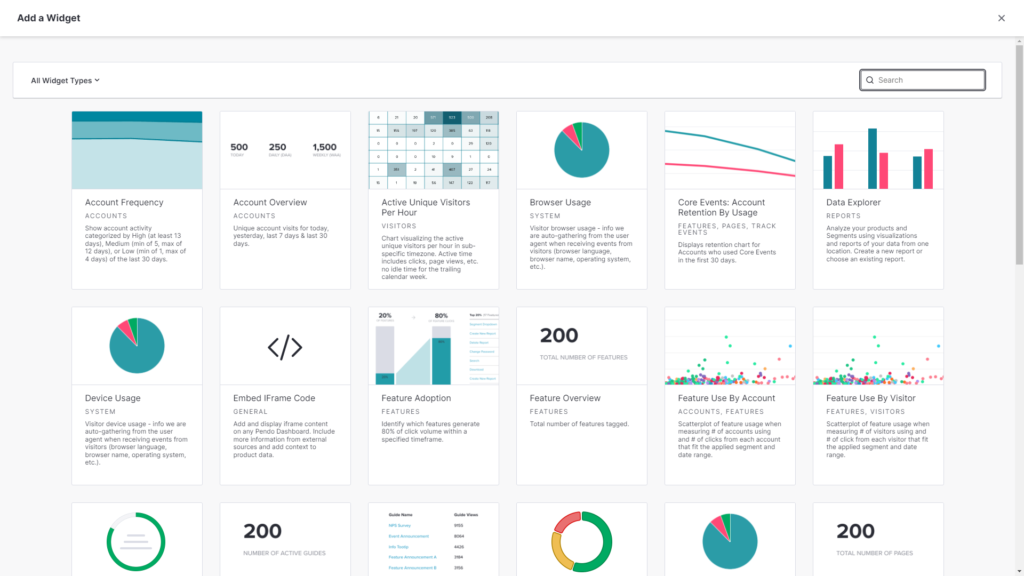
A few Pendo analytics features worth highlighting include:
- Dashboard Widgets: There are 26 different analytics widgets that you can add to your Pendo dashboard. These widgets can track feature adoption, guide engagement, user sentiment, and cohort data like which operating system is being used.
- Saved Reports: Pendo lets you view all the user behavior reports you’ve created from a single screen. Unfortunately, you won’t be able to create reports using the data explorer feature unless you upgrade to the Growth or Portfolio plan.
- Cohort Retention: The retention analytics dashboard on Pendo helps you visualize the churn rate for each cohort on a weekly or monthly timescale. You can also switch between viewing visitors/accounts, highlight segments, and adjust the date range as needed.

- Data Explorer: Pendo’s data explorer lets you create event groups that can combine data from multiple apps, events, or guides. The data explorer also comes pre-loaded with formulas for sums, ratios, and relative percentages to speed up the data analysis process. Note: The data explorer feature is only available on the Growth and Portfolio plans.
Pendo pros
Let’s take a look at some of the benefits of using Pendo:
- No-Code: Pendo lets you create surveys, in-app guides, and track metrics without needing to write your own code, which saves a lot of time (while making product experiments or split-testing a lot easier).
- Custom Themes: Pendo’s themes let you create multiple palettes and ensure that any in-app materials published align with your existing brand palette (however, you can only create/customize themes after you’ve installed the Pendo snippet).
- Flexible Dashboards: Pendo has plenty of widgets that you can add to your dashboard, including feature adoption, net promoter score, poll results, guide engagement, product stickiness, and MAUs — so you always have your most important metrics within reach.
- Integrations: Pendo has 50 different integrations to choose from including popular tools like Intercom, Jira, Okta, and HubSpot. Unfortunately, only four of these — Salesforce, Segment, Workato, and Zendesk — are two-way integrations that can share data both ways.
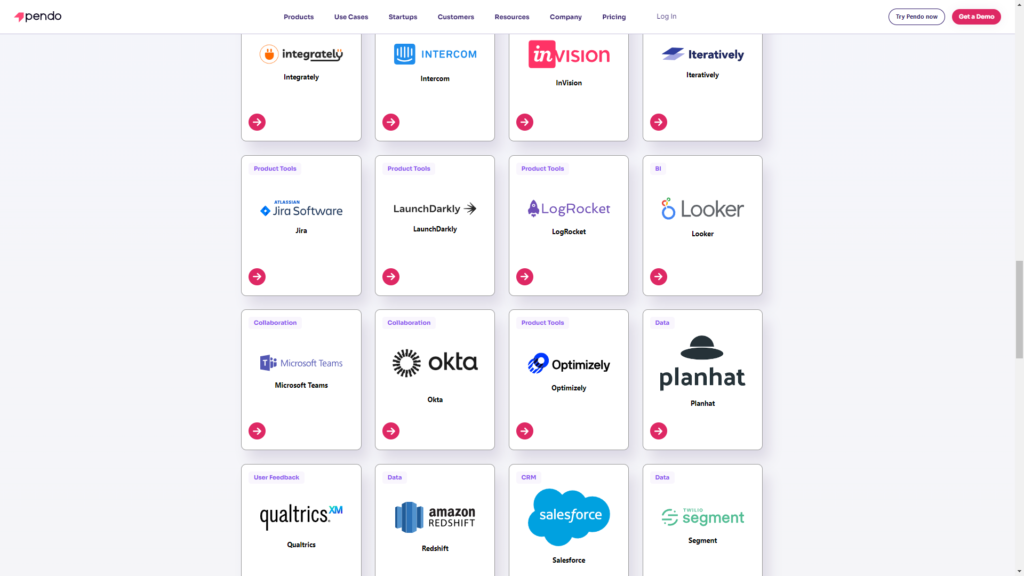
- Multi-Platform Analytics: Because Pendo is compatible with mobile applications, you’ll be able to track product analytics for both web apps and mobile apps. This gives you a more holistic view of how users (or specific segments) use your product on different platforms. Note: You’ll need to upgrade to Pendo Portfolio to add more than one product to your account.
Pendo cons
While Pendo certainly has quite a few benefits that make it an appealing solution, there are also a few notable drawbacks that you should be aware of before you choose the platform as your product adoption tool:
- Pricing Jumps: While Pendo does offer a free version, it has a limit of 500 MAUs. Upon reaching the MAU limit, you’ll need to upgrade to continue using most of Pendo’s features (and paid plans tend to cost thousands of dollars per month).
- Locked Features: Key features like the data explorer, resource center, and product engagement score are locked behind the Growth or Portfolio plan.
- Data Lag: Pendo’s analytics dashboards only update once per hour. In some cases, this data lag could lead product teams to make the wrong decisions or draw false conclusions from outdated insights.
Pendo pricing
Pricing for most paid Pendo plans (except Starter) is only provided on a quote basis and there are no listed price ranges on the solution’s website. That said, certain reviews have stated that prices start at upwards of $20,000 per year for a single product and more than twice that for higher plans.
Pendo has three paid plans and one free version that is limited to 500 MAUs which makes it accessible to startups but difficult to scale in the long run.
Here are the differences between each Pendo plan:
- Pendo Free: The free version of Pendo can accommodate 500 MAUs and has features like native analytics dashboards, feature tagging, event tracking, segmentation, NPS surveys (with Pendo branding), analytics reports, and in-app guides.
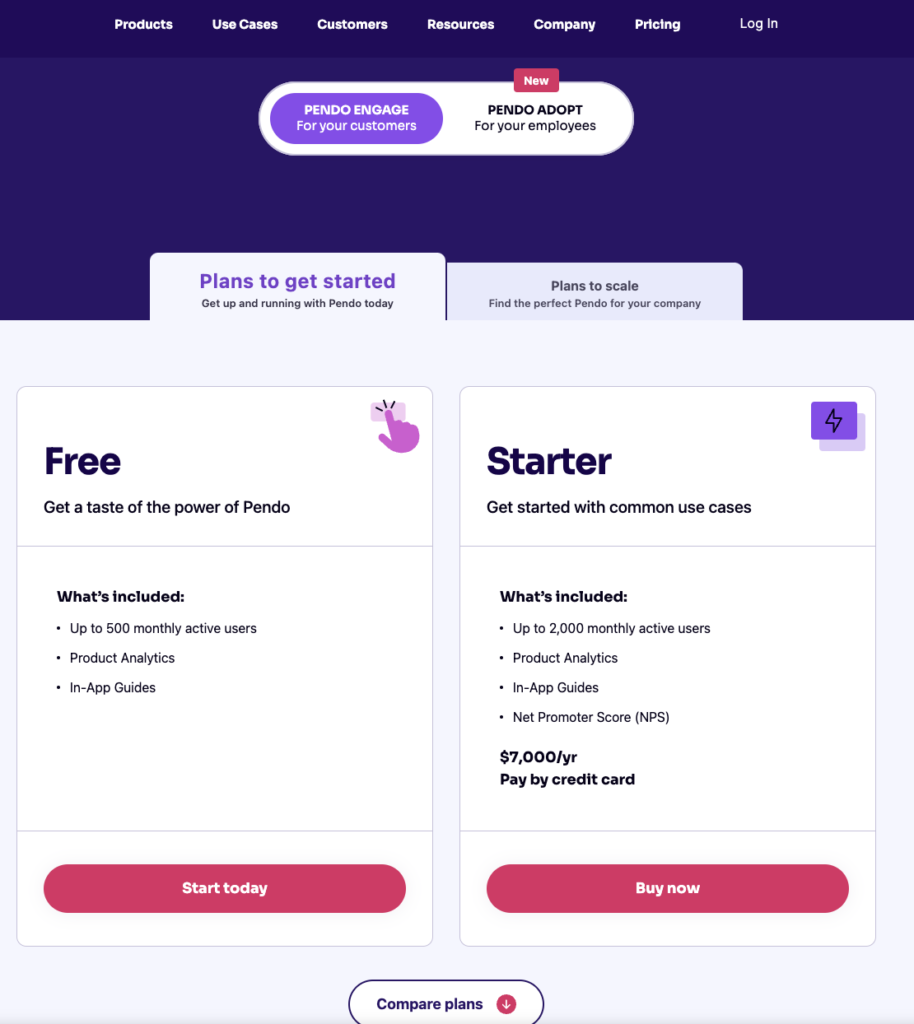
- Growth: Pendo’s Growth plan is designed to be used for a single web or mobile app but can accommodate a custom number of MAUs. It includes features like native analytics dashboards, in-app guides, NPS surveys and response tracking, and customer support.
- Starter: The Starter plan starts at $7,000 per year (or $2,000 per quarter) for 2,000 MAUs and is the cheapest upgrade option available for freemium users. Starter includes features like Product Areas, NPS surveys without Pendo branding, and (limited) NPS analytics. Note: You’ll need to upgrade to the Growth or Portfolio plan to get full NPS analytics.
- Portfolio: Pendo’s Portfolio plan is targeted towards customers who want to use the tool for multiple web and/or mobile apps. Features include guide experiment capabilities, cross-app executive dashboards, cross-app journey reporting, and access to product engagement scores.
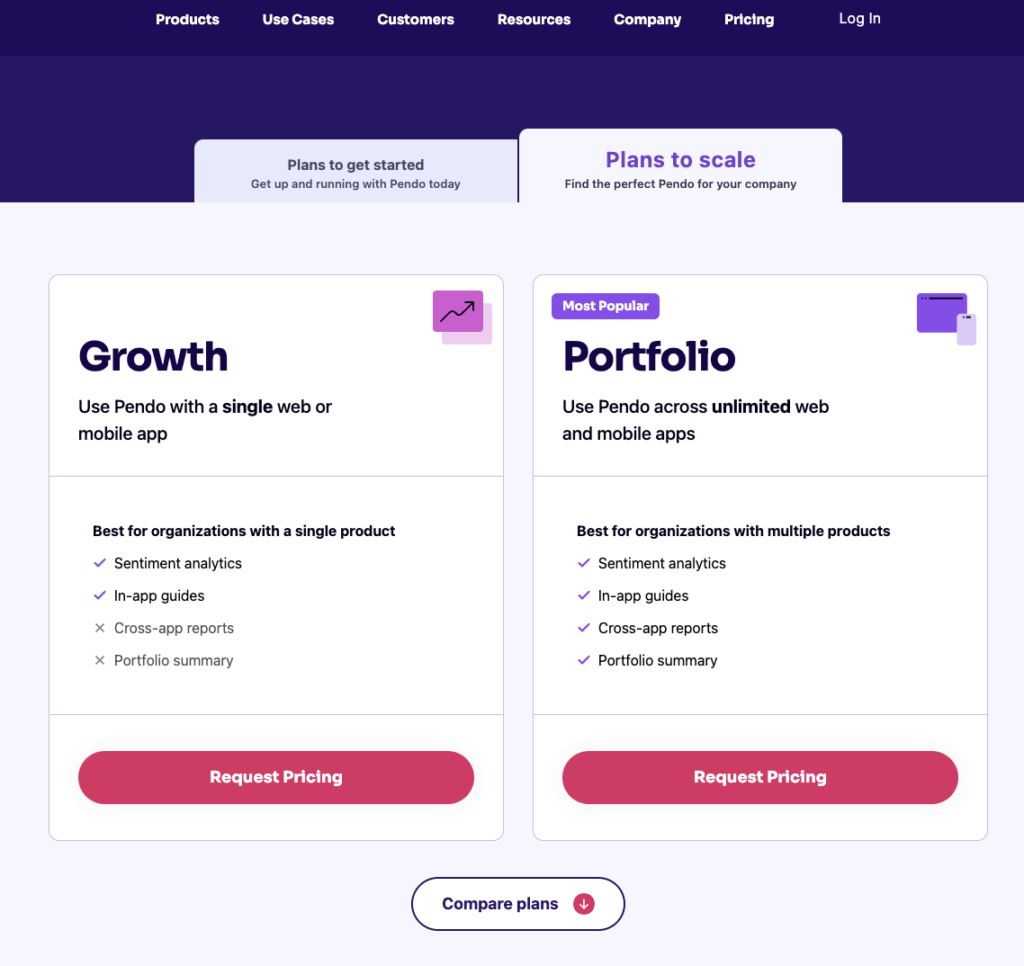
Appcues for user analytics
Appcues offers a glimpse into how users interact with in-app product tutorials, walkthroughs, and other onboarding flows. That, in turn, can help you understand and monitor user engagement and identify elements that might drive users away.
The features that come in handy include:
- Click-to-track lets you set up and monitor user actions within your product. You can use it to monitor how users navigate a page and interact with different features.

- User segmentation helps you divide your audience into different groups based on in-app behavior, demographics, etc. You can use these segments to filter event data and understand how different user groups respond to specific in-app flows, messages, and features.

- Events Explorer lets you visualize event data in the form of charts. You can even filter the results by date range or for different segments.
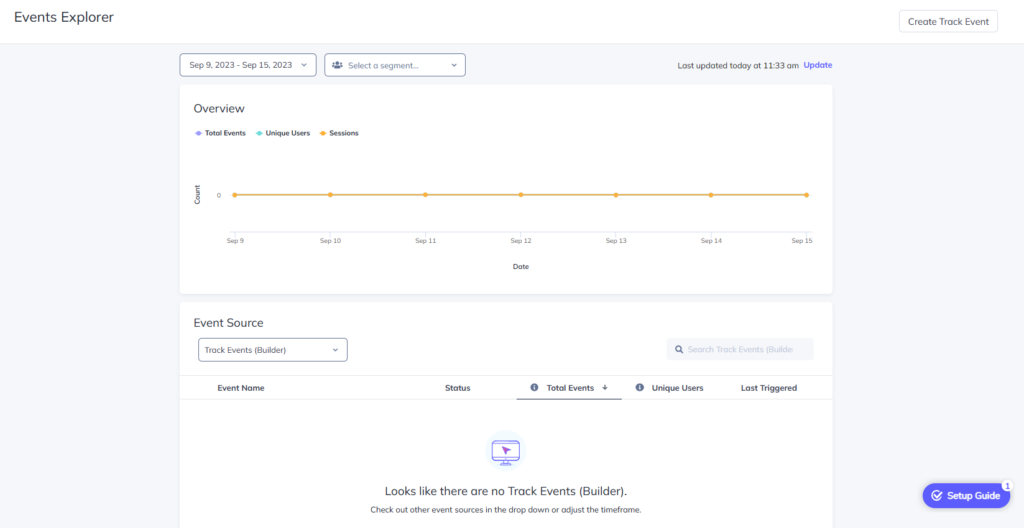
- You can publish NPS surveys to collect user feedback and assess customer satisfaction. Similarly, you can trigger in-app messages to re-engage detractors.
- It’s worth noting that Appcues only offers basic user behavioral data and analytics. For advanced analytics, you’ll have to connect it to an external tool like Amplitude or Google Analytics (which means more costs). In comparison, Userpilot offers more in-depth user data and analytics.
Appcues pros
As a first-comer in the no-code product adoption landscape, Appcues offers several valuable features. It’s suitable for mid-market SaaS businesses looking for a simple, easy-to-use tool that enhances user onboarding, retention, and the overall customer experience.
Let’s take a closer look at the benefits of Appcues:
- Intuitive UI and UX: Appcues offers a straightforward interface that’s easy to navigate and use. Users with non-technical backgrounds can design captivating in-app flows and onboarding journeys with its simple drag-and-drop builder. You can tailor user journeys with various UI patterns, from modals and hotspots to tooltips, slideouts, and banners.
- Simple setup: You can get started with Appcues in minutes by adding the SDK to your app’s source code or integrating Appcues with Segment or Google Tag Manager. Then, add a Chrome extension to launch the Appcues Builder in a few quick clicks and start creating in-app flows.
- Feedback options: Create Net Promoter Score (NPS) surveys to collect actionable user feedback. You can even check and analyze NPS analytics on your Appcues dashboard.
- Mobile onboarding: Besides web apps, you can use Appcues to create end-to-end experiences for mobile apps. It supports various mobile environments, including Native Android, Native iOS, React Native, Flutter, and Iconic.
- Extensive integrations: Appcues integrates with 20+ email automation, CRM, and analytics tools, including Heap, Zapier, HubSpot, Google Analytics, and Google Tag Manager. Many of these include two-way integrations.
Appcues cons
Appcues comes with a ton of useful features you’d expect from a leading product adoption platform, but it does have a few shortcomings.
Let’s look at a few drawbacks of Appcues:
- Poor element detection: The Appcues algorithm occasionally struggles to detect in-app elements, unlike some of its competitors like Userpilot. It’s particularly limiting when you want to add tooltips to individual options in a dropdown menu.
- Limited customization capabilities: While Appcues lets you customize pre-designed templates, you’re limited to basic options like font style, size, color, and padding. Advanced customization requires working with CSS code, which can be challenging for non-technical teams.
- Basic analytics: Appcues provides insights into product usage and customer behavior. However, you can’t access in-depth analytics without connecting to a third-party tool like Amplitude or Google Analytics.
- Limited survey options: Appcues lacks variety in feedback collection and survey options and doesn’t offer integrations with other platforms like Google Forms and Typeform. You can only build NPS surveys. This is in contrast to some of its competitors, like Userpilot, which offers an extensive library of customizable survey templates.
- Higher pricing: Starting at $249 per month, the Appcues Essential tier has several constraints, such as limited UI patterns and no custom CSS support. Moreover, localization support is only available in the Enterprise tier. If your app is multilingual, you’ll have to shell out a ton of money to make the most of Appcues.
- No live chat: While Appcues offers educational resources and a help center (Help Docs), customer support is limited to email and phone.
Appcues comes with a ton of useful features you’d expect from a leading product adoption platform, but it does have a few shortcomings.
Let’s look at a few drawbacks of Appcues:
- Poor element detection: The Appcues algorithm occasionally struggles to detect in-app elements, unlike some of its competitors like Userpilot. It’s particularly limiting when you want to add tooltips to individual options in a dropdown menu.
- Limited customization capabilities: While Appcues lets you customize pre-designed templates, you’re limited to basic options like font style, size, color, and padding. Advanced customization requires working with CSS code, which can be challenging for non-technical teams.
- Basic analytics: Appcues provides insights into product usage and customer behavior. However, you can’t access in-depth analytics without connecting to a third-party tool like Amplitude or Google Analytics.
- Limited survey options: Appcues lacks variety in feedback collection and survey options and doesn’t offer integrations with other platforms like Google Forms and Typeform. You can only build NPS surveys. This is in contrast to some of its competitors, like Userpilot, which offers an extensive library of customizable survey templates.
- Higher pricing: Starting at $249 per month, the Appcues Essential tier has several constraints, such as limited UI patterns and no custom CSS support. Moreover, localization support is only available in the Enterprise tier. If your app is multilingual, you’ll have to shell out a ton of money to make the most of Appcues.
- No live chat: While Appcues offers educational resources and a help center (Help Docs), customer support is limited to email and phone.
Appcues pricing
Pricing for Appcues starts at $249 per month, with the platform offering three distinct tiers – Essentials, Growth, and Enterprise.
The total cost can vary depending on the number of monthly active users (MAU). For instance, the Essential plan starts at $249 per month for 2500 MAU but jumps to $299 for 5000 MAU.
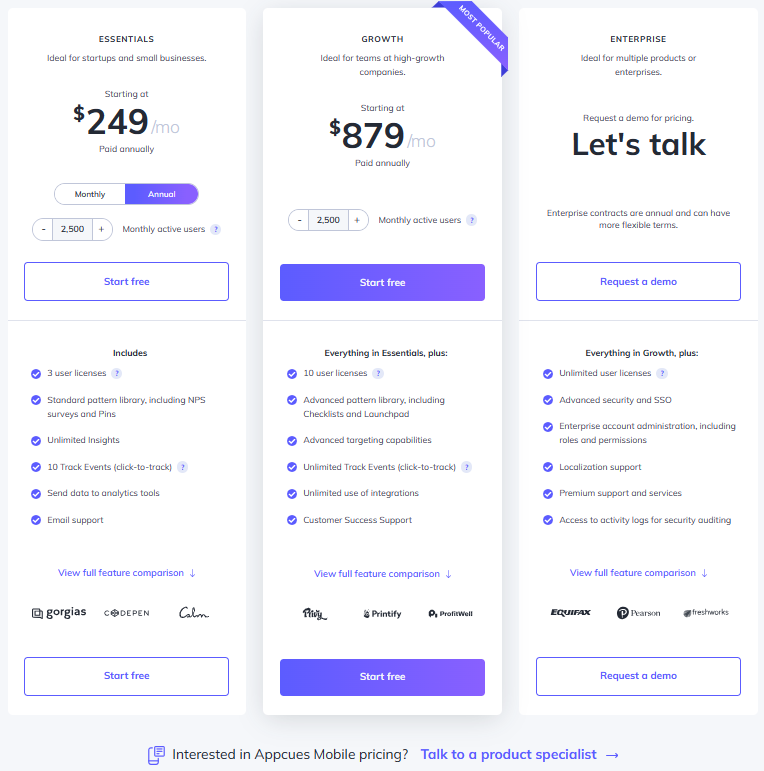
Here’s a detailed glimpse of the different pricing tiers:
- Essentials: It’s the basic tier that starts at $249 per month. It includes 3 user licenses and lets you add up to 5 audience segments. Some UI patterns, such as checklists, launchpads, and custom CSS support, aren’t available. Customer support is only available through email.
- Growth: This tier starts at $879 per month (for 2500 monthly active users) and includes 10 user licenses. You can target unlimited audience segments and use the full spectrum of UI patterns. Additionally, you can access the Premium Integrations package, which includes integrations with Slack, Salesforce, Marketo, and Zendesk.
- Enterprise: This is the most feature-packed tier and includes robust security controls like role-based access and activity logs. It’s also the only tier that comes with multi-account and localization support. Besides email and phone support, you also get a dedicated Customer Success Manager and Technical Implementation Manager. Pricing is available on request.
All three plans come with a 14-day free trial, where you can test unlimited flows and track up to 5 events. You can extend the trial by another 14 days by installing the Appcues SDK in your app. Additionally, you don’t need a credit card to sign up for the free trial.
Keep in mind that the above pricing plans are applicable to web apps. Pricing for Appcues Mobile is available on request.
It’s also worth noting that Appcues is pricier than some of the other product adoption tools available in the market, including Userpilot. For instance, Userpilot’s basic tier (Starter) lets you add up to 10 audience segments and includes the complete set of UI patterns.
Amplitude for user analytics
Amplitude offers several tools and features to help you monitor user behavior, engagement, and preferences within your digital products. From in-app user activity and new sign-ups to session durations and retention rates, you can track various metrics. Also, Amplitude quickly turns this data into easy-to-understand, shareable reports.
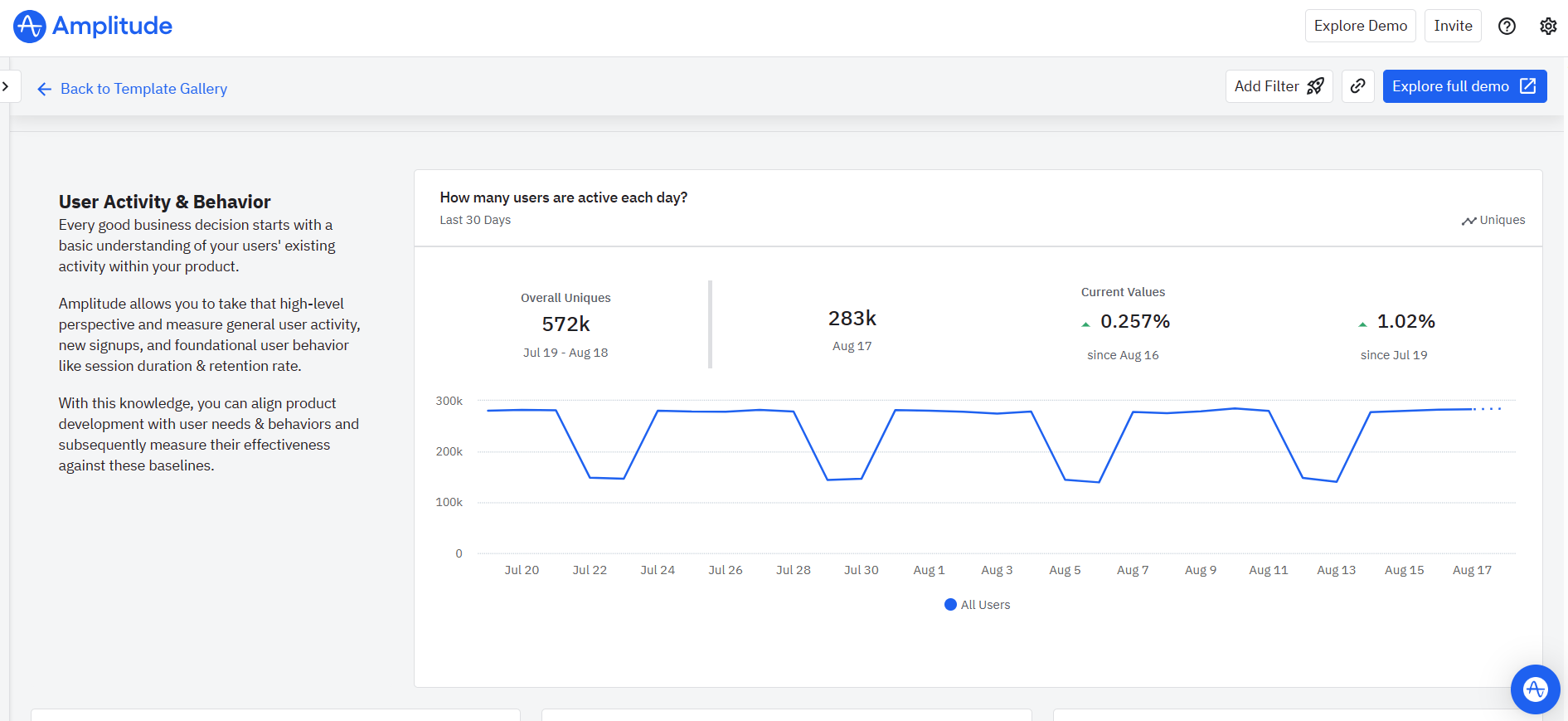
Amplitude user activity report.
When it comes to user analytics, the most helpful features include:
- Event tracking You can set up and track custom events to monitor user actions.
- User segmentation – You can group users into different segments and monitor how each segment navigates your product.
- User journey mapping – Amplitude’s Pathfinder feature helps you understand how individual users move through your product.
- Other features, such as user cohorts and retention analysis, also come in handy.
Amplitude pros
Amplitude is one of the most feature-packed stand alone product analytics platforms for digital products at the moment. It’s designed to meet the needs of modern product and growth teams that want to embrace data-driven decision-making.
Let’s take a closer look at the benefits of Amplitude:
- Advanced product analytics – Amplitude enables you to dig deep into user behavior, including how they interact with your product and where they convert or drop off.
- Cross-platform analytics – Amplitude lets you track product usage across native apps, web apps, and web pages. It can help you understand how users move between these platforms.
- Designed for collaboration – It enables you to easily share dashboards and reports with other team members. Amplitude also facilitates collaboration among different teams, including product, marketing, and customer success.
- Powerful integrations – Amplitude connects with more than a hundred platforms, including data warehouses, marketing automation tools, ad networks, and customer data platforms. This helps you harness the full potential of product and user behavior data.
- Customer education – Amplitude offers an extensive resource center and a community where you can connect with product analytics experts. Moreover, you get easy access to a chatbot and help center from your dashboard.
Amplitude cons
Despite its impressive suite of features, Amplitude comes with a few drawbacks. These include:
- Steep learning curve – Amplitude’s fully customizable dashboards can be intimidating for new users. You’ll need basic technical knowledge to set up and track events using Amplitude. It may not be particularly suitable for teams without in-house analysts.
- No user engagement functionalities While Amplitude offers a ton of user behavior data, it doesn’t provide any tools to act on these insights. In contrast, a product adoption platform like Userpilot lets you harness usage and behavior data to optimize in-app experiences.
- Lack of automated event tracking – Amplitude doesn’t automatically track events like clicks, page views, and swipes. You have to define the events you want to track before getting started.
Amplitude pricing
Amplitude offers three distinct pricing tiers:
- Starter – A free plan suitable for small teams.
- Growth – Suitable for teams that need to scale fast; pricing is available on request and depends on your requirements.
- Enterprise – Includes advanced governance and security features; pricing is available on request.
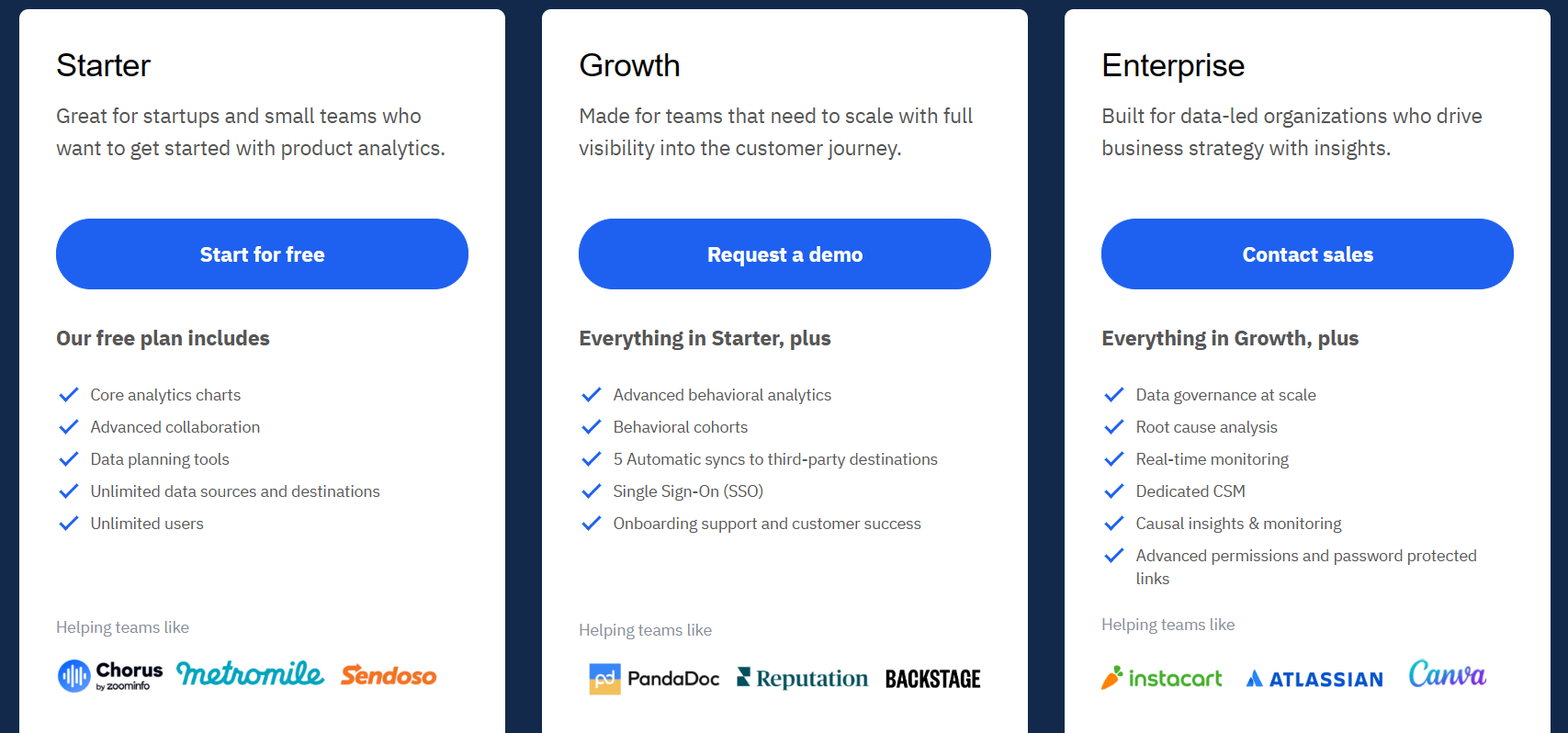
Amplitude pricing plans.
Both Growth and Enterprise plans come with a 14-day free trial. Amplitude also offers a free annual subscription to the Growth plan under the following programs:
- Scholarship Program for startups with under $5 million in funding and fewer than 20 employees.
- Black Founders Program for US startups with a Black co-founder, fewer than 150 employees, and under $30 million funding.
However, it’s worth noting that Amplitude’s pricing plans are complex because they’re based on the number of monthly events or features. Other tools like Mixpanel and Userpilot offer more transparent pricing based on the number of monthly active users.
Better alternative to Pendo, Appcues, and Amplitude
We have discussed Pendo, Appcues, and Amplitude for user analytics with their pros, cons, and pricing. Let’s take a look at a better alternative – Userpilot.
Userpilot for user analytics
User analytics lets you track and analyze the behavior of users within your product. Userpilot lets you filter through customers from a unified dashboard, extract insights from specific segments or time periods, and create custom segments for all users who meet certain conditions.
Here’s an overview of Userpilot’s analytics features:
- Users dashboard: Userpilot’s users dashboard gives you an overview of all user data in one place. You’ll be able to filter by segments, which companies users are from, or when they were last seen active. You can also export data in bulk as a CSV or perform actions on individual users.
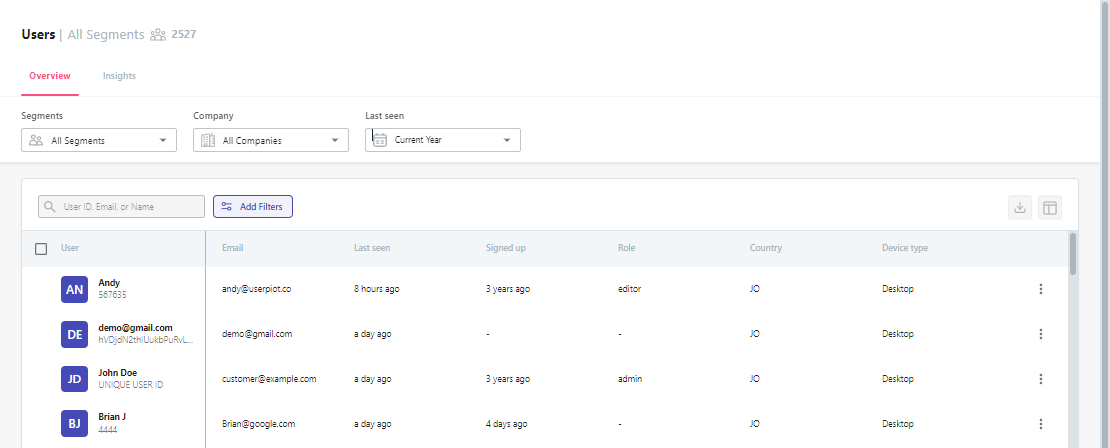
- Audience insights: Much like the overview dashboard, the Insights section lets you filter metrics by segment, company, and time period. You’ll be able to choose between a daily, weekly, or monthly view and then compare data between the current and previous time periods.

- Conditional segmentation: Practical use cases for user analytics include creating segments for all users that meet certain conditions. For instance, you could reach out to companies in a certain country when creating a new flow or target customers who have tried certain features.
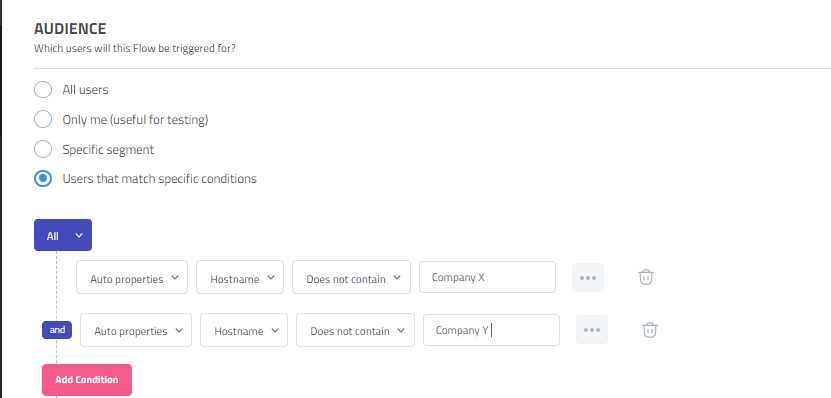
- Saved reports: The saved reports dashboard lets you view, edit, duplicate, or delete any trend and funnel reports you’ve created. You’ll also be able to sort by report type, filter by the teammate who created the report, or export in bulk if you need a CSV of your user analytics.

Userpilot pros
As a full-suite digital adoption platform, Userpilot has all the features you need to onboard users, track analytics, and gather feedback from customers without writing a single line of code. Here are a few pros of using Userpilot as your product growth solution:
- No-code builder: Userpilot’s Chrome extension lets you build flows, add UI elements, and tag features without writing a single line of code.
- UI patterns: There are plenty of UI patterns to choose from when using Userpilot, such as hotspots, tooltips, banners, slideouts, modals, and more!
- Startup-friendly: Userpilot’s entry-level plan gives you access to all available UI patterns so you can hit the ground running.
- Walkthroughs and flows: Build engaging interactive walkthroughs and personalized onboarding flows that target specific segments of your user base.
- Self-service support: Build an in-app resource center to help users solve problems, customize its appearance to align it with your brand, and insert various types of content (videos, flows, or chatbots) to keep your customers satisfied.
- A/B testing: Userpilot’s built-in A/B testing capabilities will help you split-test flows, iterate on the best-performing variants, and continually optimize based on user behavior.
- Feedback collection: Userpilot has built-in NPS surveys with its own unified analytics dashboard and response tagging to help you retarget users. There are other survey types to choose from and you can even create your own custom survey.
- Survey templates: There are 14 survey templates to choose from so you can gather feedback on specific features or run customer satisfaction benchmarking surveys like CSAT and CES.
- Advanced analytics: Userpilot lets you analyze product usage data, monitor engagement on all in-app flows, and use the data to create user segments that are based on behaviors instead of demographics.
- Event tracking: Userpilot’s no-code event tracking lets you tag UI interactions (hovers, clicks, or form fills) and group them into a custom event that reflects feature usage.
- Third-party integrations: Userpilot has built-in integrations with tools like Amplitude, Mixpanel, Kissmetrics, Segment, Heap, HubSpot, Intercom, Google Analytics, and Google Tag Manager so you can share data between all the solutions in your tech stack.
Userpilot cons
Of course, no tool is perfect and there are a few cons to consider before choosing Userpilot as your user onboarding or product growth solution:
- Employee onboarding: Currently, Userpilot only supports in-app customer onboarding.
- Mobile apps: Userpilot doesn’t have any mobile compatibility which could make it difficult for developers with cross-platform applications to create a consistent user experience for both versions of their product.
- Freemium plan: There’s no freemium Userpilot plan so those bootstrapping their startup and need sub-$100 solutions should consider more affordable onboarding platforms like UserGuiding or Product Fruits.
Userpilot pricing
Userpilot’s transparent pricing ranges from $249/month on the entry-level end to an Enterprise tier for larger companies.
Furthermore, Userpilot’s entry-level plan includes access to all UI patterns and should include everything that most mid-market SaaS businesses need to get started.

Userpilot has three paid plans to choose from:
- Starter: The entry-level Starter plan starts at $249/month and includes features like segmentation, product analytics, reporting, user engagement, user feedback, and customization.
- Growth: The Growth plan starts at $499/month and includes features like resource centers, advanced event-based triggers, unlimited feature tagging, AI-powered content localization, EU hosting options, and a dedicated customer success manager.
- Enterprise: The Enterprise plan uses custom pricing and includes all the features from Starter + Growth plus custom roles/permissions, access to premium integrations, priority support, custom contract, SLA, SAML SSO, activity logs, security audit and compliance (SOC 2/GDPR).
Conclusion
In conclusion, as we’ve explored Pendo, Appcues, and Amplitude for user analytics, it becomes evident that there is a diverse landscape of solutions available to cater to your specific needs. Each of these tools brings its own set of features, advantages, and unique capabilities to the table. Whether you’re seeking enhanced functionality, cost-effectiveness, or a different approach to tackling your tasks, our guide has showcased a range of options.
Ultimately, the choice of the best alternative depends on your individual requirements and preferences. We hope that our exploration of these tools has provided you with valuable insights to help you make an informed decision.
There is a better tool for your SaaS than Pendo!


